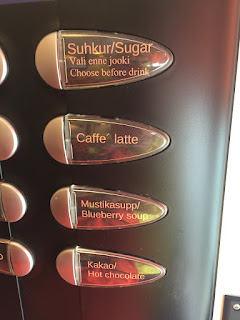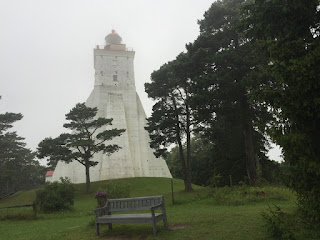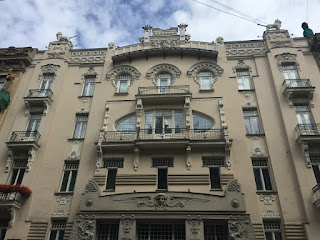After a break on the beach for a picnic lunch, we hopped back on the bus for the transfer to Haapsalu with a stop along the way in Parnu. This town is a summer resort and was once walled. This picture is the only gate left. It is supposed to be Estonia's "summer capital" but it seemed a bit of an hyperbole. Maybe if we had more time we could have explored more and sampled the mud baths.
Tallinn Gate in Parnu built when the Swedes were in charge.
Now Haapsalu is where I wish we had had more time. The hotel was right on the promenade facing the water. We opened the sliding door to the deck for a lovely view.
On the walk back from dinner
This town felt very Scandinavian rather than Russian or Eastern European. The houses were painted bright colors, some blue, some yellow, some bright green. The center of the town is the castle which was the Bishop's House back in the 1200's. Then the Danes conquered Haapsalu. Then the Swedes, Then the Russians. When we walked by the castle, there was a concert inside. Standing outside the door, we heard a wonderful orchestra with a chorus and solo vocalists. We wandered to the main street in town and chose one of the restaurants. Our server was a young woman who spoke unaccented English. It turns out she has an American father and an Estonian mother and goes back and forth to the U.S. for part of each year.
The chapel where the concert was going on.
One of the walls surrounding what is left of the castle
The city was known for its mudbaths and has what is supposed to be the longest covered train platform in Europe - the better to keep the nobility dry. Now, no trains come to Haapsalu. The grand station is simply a relic.
There were sculptures everywhere in the water along the promenade and a special memorial bench honoring Tchaikovsky who came to the spas. The bench has little speakers that play his music.
We wished we had not stopped in Parnu so that that we would have had more time in Haapsalu. The room was lovely and it would have been nice to have more time in the afternoon before dinner and more time to linger in the morning.
Early in the morning we took the bus to Rohukula to catch a ferry to the island of Hiiumaa.
Ferry to Hiiumaa
Everywhere we went throughout the Baltics, if there wasn't a little cafe serving coffee, there was a little car outfitted with an espresso machine. In a pinch, there would be a vending machine that actually served pretty decent espresso according to the coffee drinkers on the trip. The ferry to Hiiumaa had drink vending machine. This one is a new option: blueberry soup.
Hiiumaa is a sparsely settled and developed island. It has several notable lighthouses and some old Soviet bunkers scattered throughout the forests. Kopu lighthouse which was built in 1531may be the oldest operating lighthouse in the world.
Kopu Lighthouse
Ristna Lighthouse
We rode to the first lighthouse and then on to lunch. After lunch, the skies opened and it poured. No one wanted to ride in the deluge so the bikes were loaded and we rode to the Ristna Lighthouse. The rain stopped and a few of us decided to ride to our hotel. If there was an award for the hotel that most channels Soviet bloc architecture, this one would win. It was utilitarian but ugly and there was NOTHING around it, no houses, no shops, no restaurants, nothing. We had our last official dinner together with the whole group.
Romas toasting with Estonian liquor
The next morning was our last bike ride on the tour. First we biked out to Surf Paradiis. Apparently, this is a challenging surf spot. We didn't see anyone braving the wind and waves but there were plenty of advertising flags for Corona.
After our lunch stop, we biked across a tiny island called Kassari that is attached to Hiiumaa. The island ends in a spit of land that extends out into the sea. Legend says that it is the remains of a bridge that Leiger, mythical strongman, started to build to the island of Saaremaa to make it easier for his brother to come over and join him in heroic deeds. People who visit add a rock to the pile to further the bridge.
The last ride of the trip ended at a wool factory on the island where lovely handknit goods were for sale and someone demonstrated how wool became yarn on the large, ancient machines they have probably used for over a century.
Most of us sat in the sun and waited for the bikes to be loaded before the transfer to Tallin for the last night on the tour.




















































